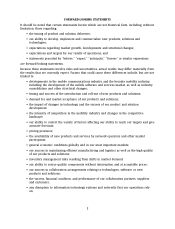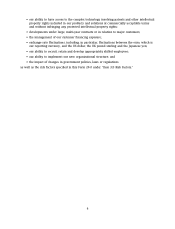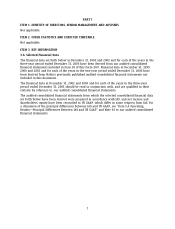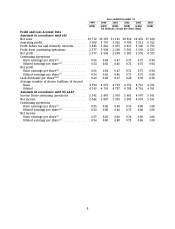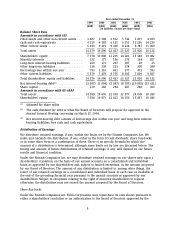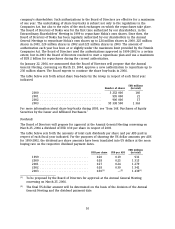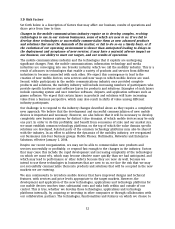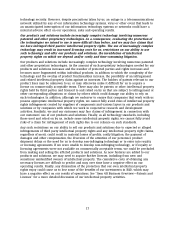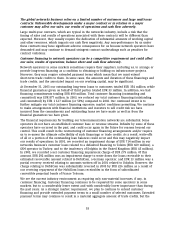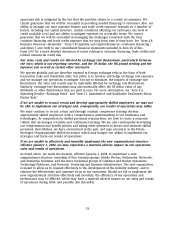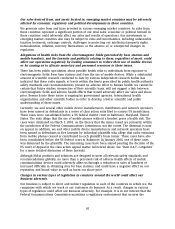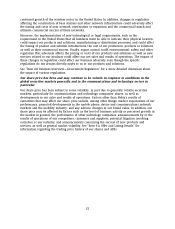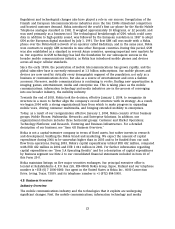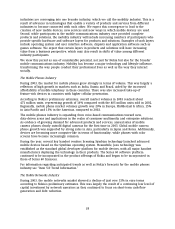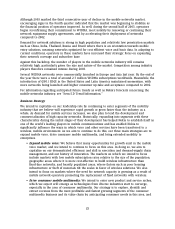Nokia 2003 Annual Report Download - page 16
Download and view the complete annual report
Please find page 16 of the 2003 Nokia annual report below. You can navigate through the pages in the report by either clicking on the pages listed below, or by using the keyword search tool below to find specific information within the annual report.seasonality; the timing and success of product and service introductions by various market
participants, including network operators; the commercial acceptance of new mobile devices,
technologies and services; fluctuations in exchange rates; operators’ and distributors’ financial
situation; and any harm suffered by the Nokia brand due to, for instance, the combination or use
of layers or components in our products and solutions which have not been authorized by us and
do not meet our and our customers’ quality, safety or other corresponding standards.
Our networks business’s quarterly and annual net sales and operating results can be affected by a
number of factors, some of which we can influence, such as our operational efficiency, the level of
our R&D investments and the deployment progress and technical success we achieve under
network contracts. Other relevant factors include operator investment behavior, competitive
pressures and general economic conditions although these are not within our control.
The new business areas that we have entered may be less profitable than we currently predict, in
particular in the short term, or they may generate more variable operating results than we
currently foresee. We expect to incur short-term operating losses in these new business areas,
given our early stage investments in R&D and marketing, in particular. Also our efforts in
managing prices and costs in the long-term, especially balancing prices and volumes with R&D
costs, may prove to be inadequate.
Finally, the recent war in Iraq and continuing incidents of terrorist activity in various parts of the
world have created uncertainties that may affect the global economy and our results of operations
adversely.
Although we may announce forecasts of our results of operations, uncertainties affecting any of
these factors, particularly during difficult economic conditions, render our forecasts difficult to
make, and may cause us not to reach the targets that we have forecasted, or to revise our
estimates.
Our sales and results of operations could be adversely affected if we fail to efficiently manage
our manufacturing and logistics, or fail to ensure that our products and solutions meet our
and our customers’ quality, safety and other corresponding requirements and are delivered
in time.
Our manufacturing and logistics are complex, require advanced and costly equipment and include
outsourcing to third parties. These operations are continuously modified in an effort to improve
manufacturing efficiency and flexibility. We may experience difficulties in adapting our supply to
the demand for our products, ramping up or down production at our facilities, adopting new
manufacturing processes, finding the most timely way to develop the best technical solutions for
new products, or achieving manufacturing efficiency and flexibility, whether we manufacture our
products and solutions ourselves or outsource to third parties. Such difficulties may have a
material adverse effect on our sales and results of operations and may result from, among other
things: delays in adjusting or upgrading production at our facilities, delays in expanding
production capacity, failure in our manufacturing and logistics processes, failure in our
outsourcing activities, and interruptions in the data communication systems that run our
operations. As part of our reorganization effective January 1, 2004, we introduced a common
Customer and Market Operations horizontal group across several business groups. If we fail to
successfully implement the new organization, it may have a material adverse effect on the
efficiency of our manufacturing and logistics. Also, a failure could occur at any stage of our
product creation, manufacturing and delivery processes, resulting in our products and solutions
not meeting our and our customers’ quality, safety and other corresponding requirements, or
being delivered late, which could have a material adverse effect on our sales, our results of
operations and reputation and the value of the Nokia brand.
15


